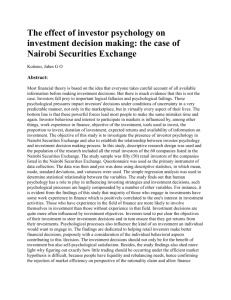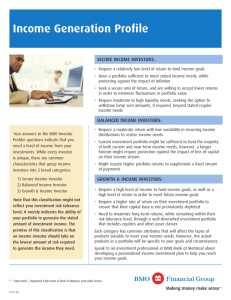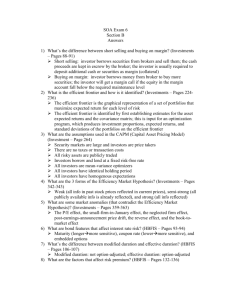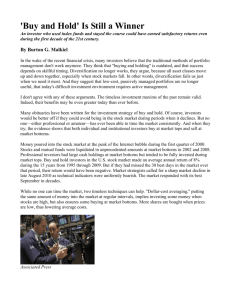Investment Analysis & Portfolio Management Lecture# 08
advertisement
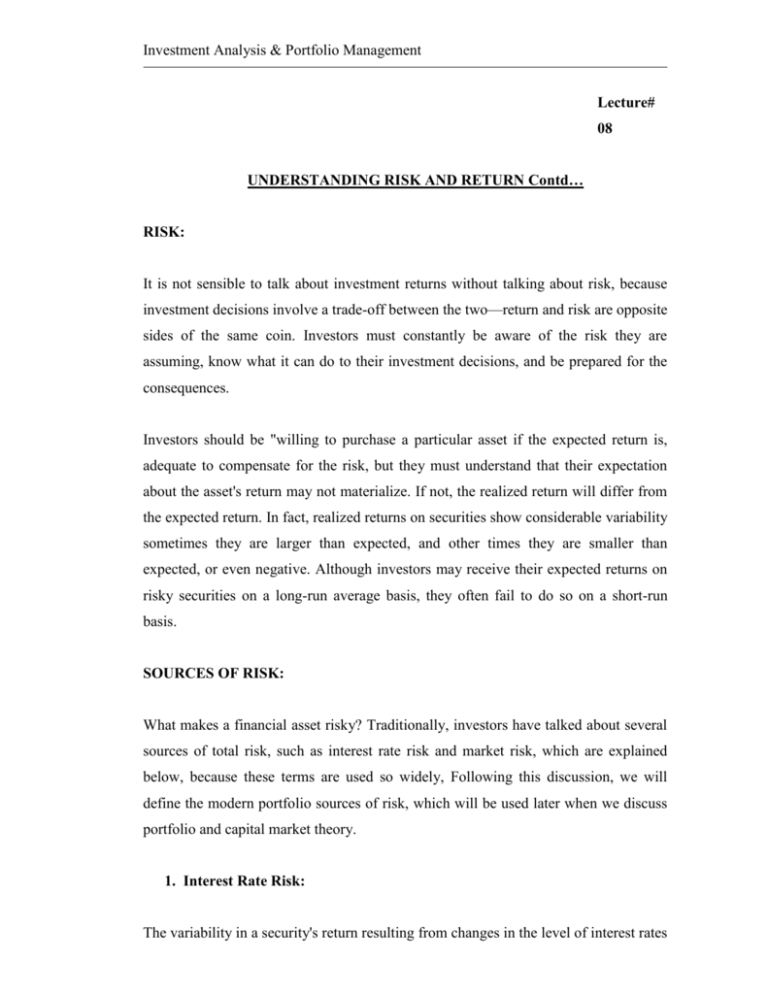
Investment Analysis & Portfolio Management
Lecture#
08
UNDERSTANDING RISK AND RETURN Contd…
RISK:
It is not sensible to talk about investment returns without talking about risk, because
investment decisions involve a trade-off between the two—return and risk are opposite
sides of the same coin. Investors must constantly be aware of the risk they are
assuming, know what it can do to their investment decisions, and be prepared for the
consequences.
Investors should be "willing to purchase a particular asset if the expected return is,
adequate to compensate for the risk, but they must understand that their expectation
about the asset's return may not materialize. If not, the realized return will differ from
the expected return. In fact, realized returns on securities show considerable variability
sometimes they are larger than expected, and other times they are smaller than
expected, or even negative. Although investors may receive their expected returns on
risky securities on a long-run average basis, they often fail to do so on a short-run
basis.
SOURCES OF RISK:
What makes a financial asset risky? Traditionally, investors have talked about several
sources of total risk, such as interest rate risk and market risk, which are explained
below, because these terms are used so widely, Following this discussion, we will
define the modern portfolio sources of risk, which will be used later when we discuss
portfolio and capital market theory.
1. Interest Rate Risk:
The variability in a security's return resulting from changes in the level of interest rates
is referred to as interest rate risk. Such changes generally affect securities inversely;
that is, other things being equal, security prices move inversely to interest rates.
Interest rate risk affects bonds more directly than common stocks, but it affects both
and is a very important consideration for most investors.
2. Market Risk:
The variability in returns resulting from fluctuations in the overall market that is, the
aggregate stock market is referred to as market risk. All securities are exposed to
market risk, although it affects primarily common stocks.
Market risk includes a wide range of factors exogenous to securities themselves,
including recessions, wars, structural changes in the economy, and changes in
consumer preferences.
3. Inflation Risk:
A factor affecting all securities is purchasing power risk, or the chance that the
purchasing power of invested dollars will decline/With uncertain inflation, the real
(inflation-adjusted) return involves risk even if the nominal return is safe (e.g., a
Treasury bond). This risk is related to interest rate risk, since interest rates generally
rise as inflation increases, because lenders demand additional inflation premiums to
compensate for the loss of purchasing power.
St. Paul’s University
195
Investment Analysis & Portfolio Management
4. Business Risk:
The risk of doing business in a particular industry or environment is called business
risk. For example, AT&T, the traditional telephone powerhouse, faces major changes
today in the rapidly changing telecommunications industry.
5. Financial Risk:
Financial risk is associated with the use of debt financing by companies. The larger the
proportion of assets financed by debt (as opposed to equity), the larger the variability
in the returns, other things being equal. Financial risk involves the concept of financial
leverage, which is explained in managerial finance courses.
6. Liquidity Risk:
Liquidity risk is the risk associated with the particular secondary market in which a
security trades. An investment that can be bought or sold quickly and without
significant price concession is considered to be liquid. The more uncertainty about the
time element arid the price concession, the greater the liquidity risk. A Treasury bill
has little or no liquidity risk, whereas a small over-the-counter (OTC) stock may have
substantial liquidity risk.
7. Exchange Rate Risk:
All investors who invest internationally in today's increasingly global investment
arena face the prospect of uncertainty in the returns after they-convert the foreign
gains back to their own currency Unlike the past when most U.S. investors ignored
international investing alternatives, investors today must recognize and understand
exchange rate risk, which can be defined as the variability in returns on securities
caused by currency fluctuations. Exchange rate risk is sometimes called currency risk.
For example, a U.S. investor who buys a German stock denominated in marks must
ultimately convert the returns from this stock back to dollars. If the exchange rate has
moved against the investor, losses from these" exchange rate' movements can partially
or totally negate the original return earned.
8. Country Risk:
Country risk, also referred to as political risk, is an important risk for investors today
probably more important now than in the past. With mote investors investing
internationally, both directly and indirectly, the political, and therefore economic,
stability and viability of a country's economy need to be considered. The United States
arguably has the lowest country, risk, and other countries can be judged on a-relative
basis using the United States as a benchmark. Examples-of countries that needed
careful monitoring in the 1990s because of country risk included the, former Soviet
Union ^and Yugoslavia, China, Hong Kong, and Smith Africa. In the-early part of the
twenty-first century, several countries in South America, Turkey, Russia, and Hong
Kong, among others, require careful attention.
TYPES OF RISK:
Thus far, our discussion has concerned the total risk of an asset, which is one
important consideration in investment analysis. However, modern investment analysis
categorizes the traditional sources of risk identified previously as .causing variability
in returns into two general types: those that are pervasive in nature, such as market risk
or interest rate risk, and
St. Paul’s University
196
Investment Analysis & Portfolio Management
those that are specific to a particular security issue, such as business or financial risk.
Therefore, we must consider these two categories of total risk.
Dividing total risk into its two components, a general (market) component and a
specific (issuer) component, we have systematic risk and nonsystematic risk, which
are additive:
Total risk = General risk + Specific risk
= Market risk + Issuer risk
= Systematic risk + Nonsystematic risk
Systematic (Market) Risk:
Risk attributable to broad macro factors affecting all securities
Systematic Risk is an investor can construct a diversified portfolio and eliminate pan
of the total risk, the diversifiable or non-market part. What is left is the nondiversifiable portion or the market risk. Variability in a security's total returns that is
directly associated with overall movements in the general market or economy is called
systematic (market) risk.
Virtually all securities have some systematic risk, whether bonds or stocks, because
systematic risk directly encompasses the interest rate, market, and inflation risks. The
investor cannot escape this part of the risk, because no matter how well he or she
diversifies, the risk of the overall market cannot be avoided. If the stock market
declines sharply, most stocks will be adversely affected; if it rises strongly, as in the
last few months of 1982, most stocks will appreciate in value. These movements occur
regardless of what any single investor does. Clearly, market risk is critical to all
investors.
Nonsystematic (Non-market) Risk:
Risk attributable to factors unique to the security
Nonsystematic Risk is the variability in a security's total returns not related to overall
market variability is called the nonsystematic (non-market) risk. This risk 1s unique to
a particular security and is associated with such factors as business and financial risk
as well as liquidity risk. Although all securities tend to have some nonsystematic risk,
it is generally connected with common stocks.
MEASURING RETURNS:
1. Total Return:
Percentage measure relating all cash flows on a security for a given time period
10 its purchase price
A correct returns measure must incorporate the two components of return, yield and
price change, as discussed earlier. Returns across time or from different securities can
be measured and compared using the total return concept. Formally, the total return
(TR) for a given holding period is a decimal (or percentage) number relating all the
cash flows received by an investor during any designated time period to the purchase
price of the asset. Total return is defined as:
St. Paul’s University
197
Investment Analysis & Portfolio Management
TR = Any cash payments received + Price changes over the
period Price at which the asset is purchased
The dollar price change over the period, defined as the difference between the
beginning (or purchase) price and, the ending (or sale) price, can be either positive
(sales price exceeds purchase price), negative (purchase price exceeds sales price), or
zero. The cash payments can be either positive or zero. Netting the two items in the
numerator together and dividing by the purchase price results in a decimal return
figure that can easily be converted into percentage form. Note that in using the TR, the
two components of return, yield and price change, have been measured.
The general equation for calculating TR is;
TR = CFt + (PE - PB)
PB
= CFt + PC
PB
Where;
CFt = cash flows during the measurement
period t PE = price at the end of period t or sale
price
PB = purchase price of the asset or price at the beginning of the
period PC = change in price during the period, or PE minus PB
The cash flow for bond pomes from the interest payments received, and that for a
stock comes from the dividends received. For some assets, such as a warrant or a stock
that pays no dividends, there is only a price change.
2. Return Relative:
It is often necessary to measure returns on a slightly different basis than TRs. This is
particularly true when calculating either a cumulative wealth index or a geometric
mean, both of which are explained below, because negative returns cannot be used in
the calculation. The return relative (RR) solves this problem by adding 1.0 to the total
return.
RR = TR in decimal form + 1.0
TR in decimal form = RR - 1.0
Although return relatives may be less than 1.0, they will be greater than zero, thereby
eliminating negative numbers.
3. Cumulative Wealth Index:
Cumulative wealth over time given an initial wealth and a series of returns on some
asset
Return measures such as TRs measure changes in the level of wealth. At times,
however, it is more desirable to measure levels of wealth {or prices) rather than
changes. In other words, we measure the cumulative effect of returns over time given
some stated beginning dollar amount invested, which typically is shown as $1 for
convenience. Having calculated ending wealth (cumulative wealth) over some period
on the base of a beginning $1, it is
St. Paul’s University
198
Investment Analysis & Portfolio Management
simple enough to multiply by the actual beginning amount, such as $10,000 or
$100,000 or
whatever the number is. The value of the cumulative wealth index, CWIn is computed,
as:
CWIn = WI0 (1 + TR1) (1 + TR2) … (1 + TRn)
Where;
CWI = the cumulative wealth index as of the end of
B
period n
WI0
TR1, = the beginning index value, typically $1
n
= the periodic TRs in decimal form
Taking a Global Perspective:
International investing offers potential return opportunities and potential reduction in
risk through diversification. Based on the historical record, investments in certain
foreign markets would have increased investor returns during certain periods-of time.
However, investors need to understand how these-returns are calculated and the risk
they are taking.
International Returns and Currency Risk:
When investors buy and sell assets in other countries, they must consider exchange
rate risk or currency risk. This risk can convert a gain from an investment into .a loss
or a loss from an investment into a gain. We need to remember that international
stocks are priced in local currencies, for example, a Swiss stock is priced in Swiss
francs and a Japanese stock is priced in yen. For a U.S. investor, the ultimate return to
him or her in spendable dollars depends upon the rate of exchange between the foreign
currency and the dollar, and this rate typically changes daily. Currency risk is the risk
that the changes in the value of the dollar and the foreign currency involved will be
unfavorable; however, like risk in general, currency risk can work to the investor's
favor, enhancing the return that would otherwise be received.
An investment denominated in an appreciating currency relative to the investor's
domestic currency will experience a gain from the currency movement whereas an
investment denominated in a depreciating currency relative to the investor's domestic
currency will experience a decrease in the return because of the currency movement.
Said differently, when you buy a foreign asset, you are selling the dollar, and when
you cash in by selling the asset, you are buying back the dollar.
Ending value of foreign
RR
currency
Total return in = x
Beginning value of foreign
Domestic terms
currency
SUMMARY STATISTICS FOR RETURNS:
The total return, return relative, and wealth index are useful measures of return for a
specified period of time. Also needed in investment analysis are statistics to describe a
series of returns. "For example, investing in a particular stock for 10 years or a
different stock in each of 10 years could result in 10 TRs, which must be described by
one or more statistics. Two such measures used with returns data are described below.
Arithmetic Mean the best known statistic to most people is the arithmetic mean.
Therefore,
St. Paul’s University
199
Investment Analysis & Portfolio Management
when someone refers to the mean return they usually are referring to the arithmetic
mean unless otherwise specified. The arithmetic mean, customarily designated by the
symbol;
X(X-bar), of a set of values is calculated as:
X = ∑X
n
or the sum of each of the values being considered divided by the total, number of
values n.
Geometric Mean the arithmetic mean return is an appropriate measure of the central
tendency of a distribution consisting of returns calculated for a particular time" period,
such as 10 years. However, when percentage changes in value over time are involved,
as a result of compounding, the arithmetic mean of these changes can be misleading. A
different mean, the geometric mean, is needed to describe accurately the "true"
average rate of return, over multiple periods.
The geometric mean return measures the compound rate of growth over time. It is
often used in investments and finance to reflect the steady growth rate of invested
funds over some past period; that is, the uniform rate at which money actually few
over time per period. Therefore, it allows us to measure the realized change in wealth
over multiple periods.
.
The geometric mean is defined as the nth root of the product resulting from
multiplying a series of return relatives together,
G = [(1 + TR1) (1 + TR2)... (1 + TRn)]1/n - 1
where TR is a series of total returns in decimal form. Note that adding 1.0 to each total
return produces a return relative. Return relatives are used in calculating geometric
mean returns, because TRs, which can be negative, cannot be used.
Arithmetic Mean versus Geometric Mean:
When should we use the arithmetic mean and when should we use the geometric mean
to describe the returns from financial assets? The answer depends on the investor's
objective:
The arithmetic mean is a better measure of average (typical) performance over single
periods. It is the best estimate of the expected return for next period.
The geometric mean is a better measure of the change in wealth over the past (multiple
periods). It is a backward-looking concept, measuring the realized compound rate of
return at which money grew- over a specified period.
Inflation Adjusted Returns:
All of the returns discussed above art nominal returns, or money returns. They
measure dollar amounts or changes but say nothing about the purchasing power of
these dollars. To capture this dimension, we need to consider real returns, or inflationadjusted returns. To calculate inflation-adjusted returns, we divide 1 + nominal total
return by 1 + the inflation
St. Paul’s University
200
Investment Analysis & Portfolio Management
rate, this calculation is sometimes simplified by subtracting rather than dividing,
producing a close approximation.
TRIA = (1 + TR) - 1
(1 + IF)
Where;
TRIA = the inflation-adjusted total return
IF
= the rate of inflation
This equation applies to both individual years and average total returns.
Risk Premiums:
A risk premium is the additional return investors expect to receive, or did receive, by
taking on increasing amounts of risk. It measures the payoff for taking various types of
risk. Such premiums can be calculated between any two classes of securities.
An often-discussed risk premium is the equity risk premium, defined as the difference
between the return on stocks and a risk-free rate (proxied by the return on Treasury
bills). The equity risk premium measures the additional compensation for assuming
risk, since Treasury bills have no practical risk (on a nominal basis). Obviously,
common stock investors care whether the expected risk premium is 5 percent, or 8
percent, because that affects what they earn on their investment in stocks. Holding
interest rates constant, a narrowing of the equity risk premium implies a decline in the
rate of return on steaks, because the amount carried beyond the risk-free rate is
reduced.
MORE ON THE RELATIONSHIP BETWEEN RISK AND RETURN:
Risk and potential return need to be analyzed together throughout the investment
decision-making process. Considering their relationship is a big part of what
investment advisers get paid to do.
The Direct Relationship:
The fundamental relationship between risk and return is well known to those
who have studied the market.
The more risk someone bears, the higher are their expected return. It also points out
that some rate of return can be earned without bearing any risk, and is called the
riskless rate of interest, or the risk free rate in finance theory. Two important points
should be noted. First, the risk-return relationship is based on expected return.
Expected return is a before the fact, not after the fact concept. It is not correct to say
that riskier securities have higher returns, although people often make this statement.
If riskier securities always had a higher return they would not be risky. Sometimes an
investor is hurt by a risk taken that resulted in a negative return. Such is the essence of
risk.
St. Paul’s University
201
Investment Analysis & Portfolio Management
The second important point is that the risk we are talking about is unavoidable, or
undiversifiable, risk. An investor is not generally rewarded for bearing risk that could
have been diversified away.
Empirical financial research reveals clear evidence of the direct relationship between
systematic risk and expected return. Riskier portfolios, on average, earn higher.
Additionally, returns on well diversified portfolios tend to plot in a generally linear
fashion. The point of this discussion is that whether looking ahead to possible future
returns or looking back at realized results, a person can usually observe this direct
relationship between risk and return. Once again, though, it is not accurate to conclude
that “higher risk means higher return.” Risky investments often lose money for their
owners over the short run. They may also earn less than “safer” investments.
St. Paul’s University
202
